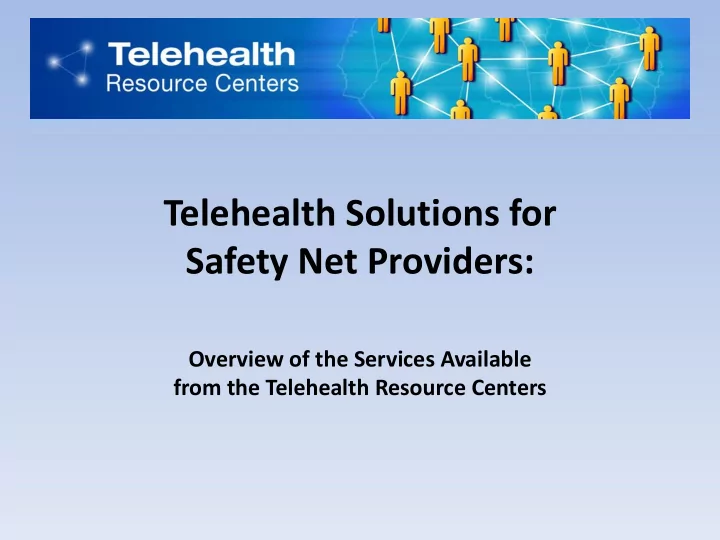

Telehealth Solutions for Safety Net Providers: Overview of the Services Available from the Telehealth Resource Centers
Presenters: Mary DeVany Jonathan Neufeld, PhD gpTRAC UMTRC
A Little History… • First TRCs originated in 2006 • Funded through the Office for the Advancement of Telehealth (OAT) – In the Office for Rural Health Policy, in HRSA • Currently: – 12 regional TRCs – 2 national, issue-specific TRCs – Cover all states, plus several territories
What do we do? • Provide guidance • Gather information • Answer questions • Share tools and resources • Provide education • Encourage collaboration • Gather regional information
Who do we serve? • Hospitals • Clinics • Providers • Safety-net Organizations • Schools • Nursing Homes • Etc.
How we can help? • On-line resources • Webinars and workshops • Presentations • Staff training • Peer to peer connections • Consultation services …and more!
Potato/Potato • Telemedicine • Telehealth • eHealth • eCare • Virtual Health • Virtual Care • Remote Health • mHealth
Key Concept • Telemedicine is not a service, but a delivery mechanism for health services – Most TM services duplicate in-person care – Some are made better or possible with TM – Reimbursement equal to “in - person” care
Domains of Telehealth Hospitals & Specialties • Specialists see and manage patients remotely Integrated Primary Care • Mental health and other specialists work in primary care settings (e.g., PCMH’s, ACO’s) Transitions & Monitoring • Patients access care (or care accesses patients) where and when needed to avoid complications and higher levels of care
Integrated Primary Care Medical Specialties – Pediatrics, Neurology, Endocrinology Mental Health – Psychiatrists, NPs, Counselors Health Behavior Change – Educators, Health Psychologists
Logistics of Integrated Care • PCP identifies referral need – Patient survey tool, chart review, registry • Discusses with patient, indicates in chart • Staff schedules patient for f/u • Patient sees tele-consultant; may return • Consultant report and plan put in chart
Developing New Services Needs Assessment • Community information, medical staff Direct Hire or Contract • Rules vary between FQHCs, RHCs, etc. Partnerships with Hospitals, Medical Gps • Existing telemedicine programs
Business Aspects - Hub & Spoke Peer-to-Peer (P2P) • Hub bills CPT service • Clinic bills encounter code rate • Spoke bills “facility • Clinic pays clinician fee” code (Part B) under contract ***(“standard” type of arrangement)
Technology: Videoconferencing – Adequate for many specialties Video + Peripherals (costs jump) – Cameras (otoscope, derm cam) – Stethoscope • Patient record access • Broadband internet
Technology Platforms H.323 Systems (“standards - based”) – Tandberg, Polycom, LifeSize, Cisco – More expensive, more complex to manage – Often necesssary for peripherals SIP Systems – Less expensive, simpler to manage – Software-based, run on a computer “YMMV”
Privacy & Security (HIPAA) • Live video stream is “patient communication” (must be encrypted) • Secure connections are available, but not always guaranteed – Security = system of documented practices • Internet chat providers won’t attest to security (Skype, iChat, Google)
Encrypted session Internet H.323 H.323 ??? Server webcam SIP SIP Encrypted sessions Internet computer
Change Management Technology Acceptance – Focus on meeting an agreed-upon need Policies & Procedures – See TRCs for examples Provider Practice Styles/Habits – Practice, practice, practice
3-Phase Project Schedule: Phase 1 – Needs assessment – Partner identification – Technology decisions Phase 2 – Partner negotiations, contracts – Policies & Procedures developed – Equipment installation, walk-throughs Phase 3 – “Go live” month
“Go - Live” Month (all via video) Week 1 – Provider introductions and discussions – Staff events Week 2 – Staff practice run-throughs (2) Weeks 3-4 – Live Clinics (2 per week, 1 practice?)
More information?
Resources: • Great Plains Telehealth Resource & Assistance Center www.gptrac.org and www.accesstelehealth.org (“telehealth101” site) • Upper Midwest Telehealth Resource Center www.umtrc.org • All Telehealth Resource Centers can be found at: www.telehealthresourcecenters.org ALSO: • American Telemedicine Association www.americantelemed.org • Center for Telehealth & e-Health Law www.ctel.org
“The general concept of health care quality does not change from urban to rural settings. The focus remains on providing the right service at the right time in the right way to achieve the optimal outcome. ” National Advisory Committee on Rural Health and Human Services Report, Health Care Quality: The Rural Context Telehealth can make a positive impact!
The National Telehealth Resource Centers Webinar Series 3 rd Thursday of every month Next Webinar: Telehealth Topic: TBD Presenter: Pacific Basin Telehealth Resource Center Date: Thursday, September 19, 2013 Times: 9:00AM HST, 10:00AM AKST, 11:00AM PST, 12:00PM MST, 1:00PM CST, 2:00PM EST
David Bingaman Deputy Regional Administrator Health Resources & Services Administration Region V Chicago, IL dbingaman@hrsa.gov
Recommend
More recommend